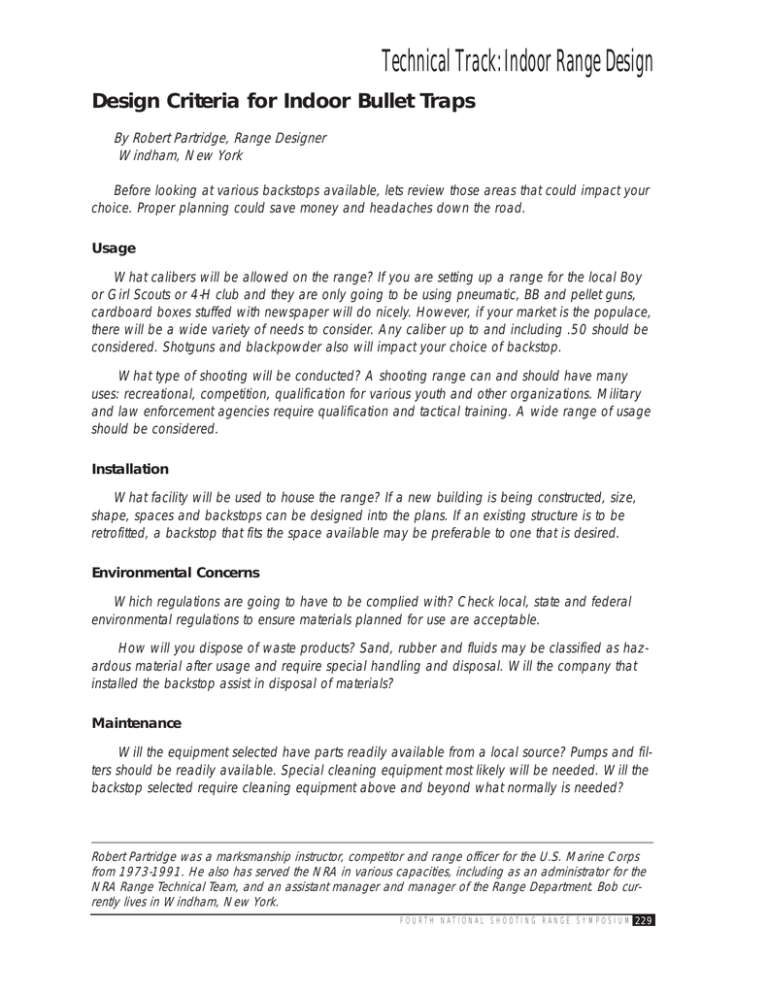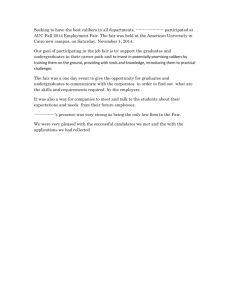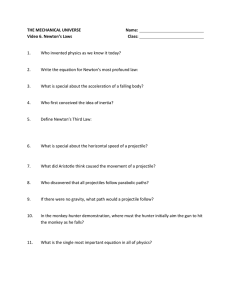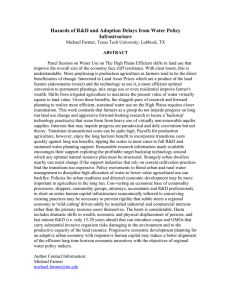Design Criteria for Indoor Bullet Traps
advertisement

Technical Track: Indoor Range Design Design Criteria for Indoor Bullet Traps By Robert Partridge, Range Designer Windham, New York Before looking at various backstops available, lets review those areas that could impact your choice. Proper planning could save money and headaches down the road. Usage What calibers will be allowed on the range? If you are setting up a range for the local Boy or Girl Scouts or 4-H club and they are only going to be using pneumatic, BB and pellet guns, cardboard boxes stuffed with newspaper will do nicely. However, if your market is the populace, there will be a wide variety of needs to consider. Any caliber up to and including .50 should be considered. Shotguns and blackpowder also will impact your choice of backstop. What type of shooting will be conducted? A shooting range can and should have many uses: recreational, competition, qualification for various youth and other organizations. Military and law enforcement agencies require qualification and tactical training. A wide range of usage should be considered. Installation What facility will be used to house the range? If a new building is being constructed, size, shape, spaces and backstops can be designed into the plans. If an existing structure is to be retrofitted, a backstop that fits the space available may be preferable to one that is desired. Environmental Concerns Which regulations are going to have to be complied with? Check local, state and federal environmental regulations to ensure materials planned for use are acceptable. How will you dispose of waste products? Sand, rubber and fluids may be classified as hazardous material after usage and require special handling and disposal. Will the company that installed the backstop assist in disposal of materials? Maintenance Will the equipment selected have parts readily available from a local source? Pumps and filters should be readily available. Special cleaning equipment most likely will be needed. Will the backstop selected require cleaning equipment above and beyond what normally is needed? Robert Partridge was a marksmanship instructor, competitor and range officer for the U.S. Marine Corps from 1973-1991. He also has served the NRA in various capacities, including as an administrator for the NRA Range Technical Team, and an assistant manager and manager of the Range Department. Bob currently lives in Windham, New York. F O U R T H N A T I O N A L S H O O T I N G R A N G E S Y M P O S I U M 229 The cleaning schedule will require down time of range operation. Length of time between cleanings and the amount of time required to conduct cleanings will impact range usability. Costs Always consider the bottom line. Prices given are per linear foot and provided as a guide when considering various backstops. Contact backstop vendors for actual costs. Price ranges are: low—less than $1,500; moderate—$1,500 to $2,000; and high—$2,000 and up. Now that you have considered the who, how and why of your market, lets look at the various types of bullet traps available. Sand Berm This backstop consists of a sand pile into which the fired projectile impacts and is captured. Cost of installation is low. It will handle all calibers up to and including .50. Sand is durable and requires moderate upkeep and maintenance. The downsides are that it is dusty, may produce ricochets and back splatter from incoming projectiles impacting those in the catch basin, and used sand may be considered a hazardous material upon disposal. Granulated Rubber Berm This backstop consists of a pile of granulated/chipped rubber into which the fired projectile impacts and is captured. Cost of installation is low to moderate. It will handle all calibers up to and including .50. It is durable and requires moderate upkeep and maintenance. The downsides are that rubber may be considered a fire hazard, ricochets and back splatter from incoming projectiles impacting those in the catch basin, and used rubber may be considered a hazardous material upon disposal. 230 F O U R T H N A T I O N A L S H O O T I N G R A N G E S Y M P O S I U M Metal Backstop With Sand Catch Medium This backstop consists of an angled metal impact plate which deflects the projectile into a sand catch basin. Cost of installation is low to moderate. It will handle most calibers, dependent on metal material and thickness. It is durable and requires low upkeep and maintenance. The downsides are dust, bullet fragmentation which could result in lead dust, ricochets and back splatter, frequent cleaning schedule, and used sand may be considered a hazardous material upon disposal. Metal Backstop With Water Catch Basin This backstop consists of an angled metal impact plate which deflects the projectile into a water catch basin. Cost of installation is low to moderate. It will handle most calibers, dependent on metal material and thickness. It is durable and requires low upkeep and maintenance. The downsides are bullet fragmentation which could result in lead dust and high moisture due to water evaporation. Louvered or Venetian-blind This backstop consists of multiple horizontal chambers into which the projectile is deflected and contained. Cost of installation is moderate. It will handle most calibers, dependent on metal material and thickness. It is durable, requires low upkeep and maintenance, and requires little space. The downsides are bullet fragmentation, lead dust and ricochets. F O U R T H N A T I O N A L S H O O T I N G R A N G E S Y M P O S I U M 231 Chambered or Escalator This backstop consists of angled metal impact plate with a deceleration chamber into which the projectile is directed, losing its inertia and falling into a collection mechanism. Cost of installation is moderate. It will handle most calibers, dependent on metal material and thickness. It is durable and reduces lead dust, and projectile collection is relatively easy. The downsides are possible bullet fragmentation and maintenance required to keep deceleration chamber clear of lead buildup. Lamell or Layered Rubber This backstop consists of layers of rubber and fabric curtains into which the projectile is fired and captured. Cost of installation is moderate to high. It will handle most calibers, dependent on depth of curtains. It requires little space, and reduces fragmentation and lead dust. The downsides are maintenance required, replacement of material, disposal of material and fire hazard. It is suggested this backstop be used under low-volume conditions, i.e., tactical training situations. 232 F O U R T H N A T I O N A L S H O O T I N G R A N G E S Y M P O S I U M Contained Granulated Rubber This backstop consists of granulated rubber contained behind a curtain into which projectiles are fired and captured. Cost of installation is moderate to high. It will handle most calibers, dependent on depth of compaction. It reduces fragmentation and lead dust. The downsides are maintenance required, material replacement, disposal of material and fire hazard. It is suggested this backstop be used under low-volume conditions, i.e., tactical training situations. Rubber Block This backstop consists of formed rubber blocks much like concrete blocks into which projectiles are fired and captured. Cost of installation is moderate to high. It will handle most calibers, dependent on depth of block wall. It reduces fragmentation, lead dust and space required. The downsides are required maintenance, material replacement, disposal of material, fire hazard and weight of material upon itself. It is suggested this backstop be used under low-volume conditions, i.e., tactical training situations. Fluid Wash This backstop consists of metal impact plates with a flow of fluid down its surface into which projectiles impact and are directed into a deceleration chamber. Cost of installation is high. It can be designed to handle all calibers up to and including .50. It is durable, reduces bullet fragmentation and lead dust, and projectile collection is relatively easy. The downsides are maintenance and space required. F O U R T H N A T I O N A L S H O O T I N G R A N G E S Y M P O S I U M 233 Tunnel or Vertical Chamber This backstop consists of a tunnel or chamber into which projectiles are directed and captured. It is basically a deceleration chamber set on end. Cost of installation is moderate to high. It will handle most calibers, dependent on material and thickness. It is durable, and projectile collection is relatively easy. The downsides are fragmentation, lead dust and ricochets. Total Containment This backstop consists of gentle sloped metal impact plates which direct projectiles into a collection chamber. Cost of installation is moderate to high. It can handle all calibers up to and including .50. It is durable, reduces bullet fragmentation and lead dust, and projectile collection is relatively easy. The downside is space required. 234 F O U R T H N A T I O N A L S H O O T I N G R A N G E S Y M P O S I U M




